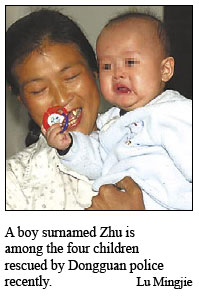Three-year-old Wenwen returned home last week after being reported missing for about 50 hours.

The boy was kidnapped while playing near his house, a room rented by his parents, in Xiegang town of Dongguan. Police rescued him from a person's home 400 km away, where kidnappers had sold him for 18,000 yuan ($2,630).
Wenwen is one of the four children Dongguan police have rescued recently, taking the total number since 2000 to 138.
"But 121 kidnapping cases are yet to solved," said Li Zhuohua, a Dongguan police officer. The huge population of migrant workers in the manufacturing city has made it easy for kidnappers to target their children.
Kidnapping became rampant around 2000, Li said, and is reported often even now.
The method kidnappers seem to favor the most is befriending kids with the promise of giving them toys or candies if they follow them to a certain spot. Others make friends with a targeted child's parents. They abduct the kid as soon as the parents drop their guard.
The more daring ones just lift a child when its parents are not watching. Wenwen's kidnappers employed this method. "My son was 'lost' in the blink of an eye," his father Zhou Hua said.
Zhou was lucky because neighbors reported to police that they had seen a suspicious looking woman surnamed Zhang loitering around his house. Police picked up the woman, who helped them track down the child.
Zhou should thank the Ministry of Public Security, too, which began a 9-month nationwide campaign last month to prevent kidnapping of women and kids. Since then police have taken significantly less time to rescue kidnapped children.
Last week, the authorities launched a nationwide DNA databank to help identify abducted children and return them to their families. Medics will collect blood samples of parents who report their kids missing and store them in the databank.
This will allow scientists to match the DNA samples of suspected kidnap victims or homeless kids found loitering or begging on streets with that of the parents' in the databank, the ministry said.
Earlier, the ministry had said 2,000-3,000 cases of women and children being sold were reported across the country every year. Experts say the figure is much higher, though.